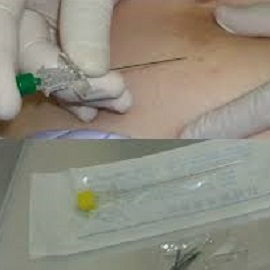
Thread embedding is used to refer to a group of medical practices which are characterized by inserting small absorbable surgical threads into specific acupoints or body parts to produce a long gradual therapeutic effect during a couple of weeks to a couple of months. The main origin of these methods is oriental medicine or Korean medicine. But, it is gradually finding its fans all around the world because in contrast to acupuncture it doesn’t need repeated visits over the weeks and the therapeutic effect will be obtained over few visits with 2-3 weeks intervals. Thread embedding can be categorized into two main groups: sporadic embedding and linear embedding.
- Sporadic embedding: this method of embedding includes inserting small (2 cm) absorbable threads in specific acupoints which can be used for special patients. The inserted thread will form a spiral position and makes a small ball over the site of insertion. In addition to mechanical stimulation of the acupoint, it produces a local inflammation which stimulates the acupoint like the needle is inserted. In obese patients, the inflammation can mobilize the deposited fat and cause local thinning effects. The main receivers of this methods are those who cannot attend the normal acupuncture sessions (two or three times a week) due to time limitations, suffering from disabilities (like elderly, being bed ridden or wheelchair bound) or having no local access to an acupuncturist. The most common users of this method are medical tourists who go to another city or country for acupuncture services. The most common type of thread used for embedding is catgut which is obtained from intestine of animals. However, some patients are allergic to this kind of thread. For such people, there are hypoallergenic alternatives which are synthetic absorbable threads such as PDS or PDA. The main purpose of using sporadic embedding is for weight loss, pain and inflammation control in joint and muscle problems and some general conditions such as irritable bowel disease. Most commonly, patients visit acupuncture clinics to receive embedding for weight loss. In such cases, it is needed to repeat the procedure for three times every 3 weeks. The weight loosing effects will be produced only after 2 months of treatment.
- Linear thread embedding can be categorized into stimulatory linear embedding and lifting linear embedding. In stimulatory linear embedding a simple soft absorbable thread is inserted in a line with 2 to 10 cm long. With gradual dissolution of the thread, a local inflammation can dissolve the neighboring fat tissue and stimulate the fibroblasts to make new collagen. The final effect of this reaction is to decrease the fat deposited in the place and having a new collagen tissue and collagen web. This method is mainly used to fill-up the deep wrinkles in face and make the skin stronger to treat sagging chin or arms. It is also used with lifting linear embedding to empower its effects. In lifting linear embedding dotted traction threads are used. Dots are actually very small spurs which are designed to be attached to the skin and soft tissue and cause a gentle traction over the time. It can lift the sagging skin and makes a much better appearance just after insertion of the threads. This method is nicely used for lifting of different organs such as abdomen, breasts, arms, thighs, buttocks, etc. as mentioned before the primary lifting effect can be observed just after the insertion of the threads. But, the final picture will be obtained after a month.
Putting all together, it is necessary to mention that the embedding is a very powerful method for managing many medical problems. However, the traditional acupuncture is more affordable, less painful and safer. Many physicians suggest to keep the embedding methods just for those who cannot follow the usual acupuncture protocols.